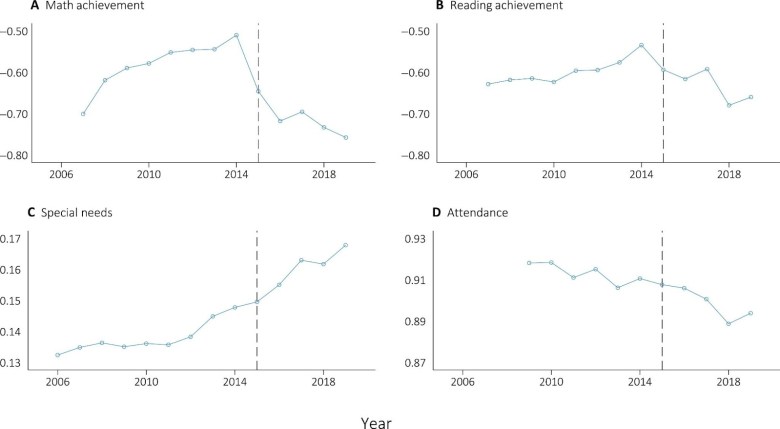When the water crisis emerged, public-school students in the majority-Black city fell behind their peers. No one knows how they’ll catch up. (Photo: Unsplash/Zoe VandeWater)
By Aziah Siid
Word In Black
April 25 marked exactly 10 years since a tragic story of environmental and racial injustice began in Flint, Mich. An unelected bureaucrat decided that saving $5 million over two years was worth risking the health and futures of thousands of children in the majority-Black city. The city’s drinking water supply was switched from the reliable Lake Huron to the toxic Flint River, releasing a torrent of lead and poisoning a generation.
Due to the crisis, health researchers found blood lead levels in Flint’s children doubled from roughly 2.5 percent to 5 percent. Under CDC guidelines, even minuscule detectable levels of lead in blood are associated with difficulties in learning, developmental delays and behavioral issues.
Sign up for our Daily eBlast to get coverage on Black communities from the media company who has been doing it right for over 130 years.
And now a new study published in “Science Advances” by a team of researchers from Princeton University and the University of Michigan finds that the seemingly benign decision to switch the city’s water source — and the lead poisoning that accompanied it — triggered an academic setback for a generation of Flint schoolchildren.
Analyzing standardized test scores from 2007 to 2019, researchers found that, after the crisis, students lost the equivalent of five months of learning progress in math — and they hadn’t recovered by 2019. They wrote, however, that they “did not observe a significant detectable effect on reading achievement in our main analysis.”
But that’s just what can be quantified on standardized tests.
One former Flint public school teacher, reflecting on her classroom experience, believes the literacy rate among the city’s schoolchildren may have plunged drastically — motivation for her to create a nonprofit organization to help them catch up.
“One of the big things we dealt with was the declining literacy rates due to the water crisis,” says Danielle Green, who taught for two decades and is CEO of EMPOWER The People, an organization she founded to help Flint’s youth.
“I think the literacy rates dropped 75 percent” since the crisis, she says.
Black students left behind
To be clear, there were problems in Flint’s schools before the water crisis made headlines. A decade ago, in 2014, roughly 56 percent of Flint’s population was Black and 37 percent was White, but four schools had fewer than 10 percent White students — meeting the threshold of “intensely segregated,” according to UCLA’s Civil Rights Project.
“It tells me about an exodus of the White population,” retired principal Willa Hawkins said at the time.

A 2017 report on the Flint Water Crisis from the Michigan Civil Rights Commission found that in Flint, “White students’ needs were almost always addressed first, including placement in the newer and better schools, while all but a very few black students were denied access to programs that would open the door to higher education and greater opportunity.”
In addition to experiencing these harms related to racial and educational segregation, just over 42 percent of Black people in Flint were living in poverty in 2014.
Poverty had a disproportionately negative impact on the Black community in Flint, particularly for children. Previous studies have shown that children from low-income households nationwide typically struggle in the classroom compared to their more affluent peers, due to factors ranging from hunger to homelessness. And schools in poorer neighborhoods are usually under-resourced compared to schools in wealthier districts.
But the water crisis made a bad situation in Flint even worse.
People complained about the look, foul smell, and taste of the water, but city officials repeatedly assured them it was safe. As the crisis wore on, however, adults and children using water from the tap began coming down with strange rashes and other illnesses. Detailed tests on the water found it had been contaminated with dangerous levels of bacteria and lead from aging pipes in the city’s water system.
“In light of what high levels of lead can do to our children’s cognitive and emotional well-being, we clearly need a long-term solution to ensure our children have access to clean, safe drinking water,” then-Flint Community Schools Superintendent Bilal Tawwab said in fall 2015.
Outraged residents demanded action, but the city, state, and federal governments were at odds on how to proceed and who was to blame.
‘How did we get so lucky?’
Meanwhile, the effects of the water crisis began showing up in the classroom — and not just among children exposed to lead in water at home. Math scores plunged, particularly among boys, and the city’s school system saw an 8 percent increase in the number of students referred for special education.
Green, the former Flint teacher, was working at Durant-Tuuri-Mott Elementary School as a classroom teacher and saw what was happening to her students in real time, long before academic studies caught up to them. She recalls a meeting in which the Flint school board waved away concerns about lead pipes in her school’s water system.
“I remember asking about the pipe, and they said that our pipes did not need to be replaced in the school, and I said, ‘Why?’” Green says. “How did we get so lucky? So everything around us, everything in front of us, in the back of us to the left, and to the right of us needs to be replaced, but we don’t?’
In 2020, Flint’s public school system saw more than 1 in 4 kids receive special education services, as previously reported by Word In Black. The overdiagnosis of Black students for special education is real, but there’s no safe amount of lead to consume.
Lead exposure in early childhood is associated with a host of negative outcomes aside from the decline in scores, including “increased anxiety, increased behavioral problems, decreased executive functioning, decreased academic achievement, decreased brain volume, higher rates of criminal offending, and decreased social mobility,” according to the Science Advances study.
“While lead exposure in Flint children increased modestly on average, some children were exposed to high lead levels,” the authors wrote. “We find decreases in math achievement and increases in special needs classification, even among children living in homes with copper (rather than lead) water service lines.”
 (Courtesy of Word In Black)
(Courtesy of Word In Black)
Perhaps not surprisingly, “Low socioeconomic status students and younger students experienced the largest effects on math achievement, and boys experienced the largest effects on special needs classification,” according to the study. “Our results point toward the broad negative effects of the crisis on children and suggest that existing estimates may substantially underestimate the overall societal cost of the crisis.”
Teachers called child protective services
Beyond the academic toll she saw, Green also witnessed the horror of students suffering from the health effects of consuming the toxic water.
“I would do one-on-ones with children, and I would start to see a lack of hair, bald spots, patches,” Green says.
In addition, teachers themselves sometimes ignored what was going on with their students. Green notes that many of the teachers who worked at her school and others in the city didn’t live in Flint.
“A lot of the educators are not Flint teachers,” she says. So, while the city’s children quite literally had their futures poisoned, the very educators entrusted with their care and development proved unwilling to help — and sometimes made things worse.
“They didn’t concern themselves with as much as I think they needed to,” Green says. “So it was to the point where there were conversations being had on calling child protective services on parents because they weren’t bathing their children.”
All children living in Flint
Researchers also found that children who weren’t directly exposed to the contaminated water, whose homes didn’t have contaminated pipes, still face academic challenges. They study authors wrote that the Flint Water Crisis “affected all children living in Flint, not only those children who experienced elevated lead exposure (just as the COVID-19 pandemic affected children who never contracted the virus).”
That may be due “to the psychosocial impacts of a child experiencing a crisis or may have operated through other non-lead pathways.”
In other words, a constant backdrop of racial trauma and upheaval, of scared parents and oblivious teachers failing to grasp the crisis. The anxiety of watching friends get sick while adults debate what to do. The fraying of communal trust and the looming threat of invisible toxins casting a shadow on their lives.
Or maybe the children understood the racial subtext of a predominantly Black city being poisoned by its own government, sacrificed in the name of austerity. The realization that their lives had so little value to those in power. A new generational scar tissue forming over the open wound of structural racism.
And it was all preventable.
Hey Super Girl
Green now devotes her time to “things to make sure children fall in love with reading” and boost their self-esteem. Over the past few years, she developed several children’s book series—”Sky’s the Limit” for little boys and the “Hey Girl” collection, with titles like “Hey Pretty Girl,” “Hey Smart Girl,” and “Hey Super Girl.”
Green says she wants Flint’s kids to be able to say, “Oh, that looks like me, I can relate to this.” And she wanted them to know there’s still hope in the world and they can change Flint for the better. In “Super Girl,” Green says “the main character name is Michaela, and it’s about a little girl who helps with the water crisis.”
But her heart still breaks over what’s happened in Flint, and she’s still angry at the willingness to let children get sick and suffer.
“I’m not sure what the angle on any of those things was,” Green says, “where people just decided we’re not gonna get these babies’ pipes replaced or clean water.”
This article was originally published by Word in Black.
Get your AFRO A CARD today!
Help us Continue to tell OUR Story and join the AFRO family as a member. Members will receive exclusive journalism, and directly support the future of the AFRO. You can choose from three membership plans below.



